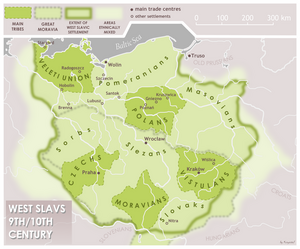West Slavs




The West Slavs are Slavic peoples speaking West Slavic languages. Czechs, Kashubians, Poles, Slovaks, and Sorbs are the ethnic groups that originated from the original Western Slavic tribes. The societies of the West Slavs developed along the lines of other Western European nations by coming into political affiliation with the Roman Empire.[1] The West Slavs experienced a cultural split with the other two main Slavic groups: while the East Slavs and most South Slavs converted to Orthodox Christianity, thus being culturally influenced by the Byzantine Empire, the West Slavs along with the westernmost South Slavs (Croats and Slovenes) converted to Roman Catholicism, thus coming under the cultural influence of the Latin Church. (Sometimes, the term "West Slavs" includes these Catholic South Slavs.)
Contents |
History
The first Slavic states, known through written sources, to be inhabited by West Slavs were the Empire of Samo (623 - 658), the Principality of Moravia (8th c. - 833), the Principality of Nitra (8th c. - 833) and Great Moravia (833 - c. 907). The Sorbs and other Polabian Slavs like Obodrites and Veleti came under direct Holy Roman Empire domination after Wendish Crusade[2] in middleages and had been strongly germanized by Germans at the end of 19th century. The Polabian language survived until the beginning of the 19th century in what is now the German state of Lower Saxony.[3] The central Polish tribe of Polans created their own state in the 10th century with the Polish duke Mieszko I. For many centuries Poland has had close ties with its western neighbours, with the Polish ruler Bolesław I the Brave declared by Holy Roman Emperor Otto III as "Frater et Cooperator Imperii" ("Brother and Partner in the Empire")[4]. The Czechs created their own state, Bohemia, in the 10th century and became part of the Holy Roman Empire , but unlike Poland, Bohemia became incorporated in the Empire. The Slovaks gradually came under Hungarian domination in the 10th - 11th century. Both the Czechs and the Slovaks were under the Habsburg monarchy from 1526 to 1918 (Austria-Hungary from 1867 to 1918). Since 1569 the only independent Slavic states were the Polish-Lithuanian Commonwealth and the Tsardom of Russia. After the 1795 partition of the Commonwealth, Russia became the only one for 123 years to end of World War I.
West Slavic ethnic groups ca. 10th c.
- Lechitic group
- Poles
- Masovians
- Polans
- Vistulans
- Lendians
- Silesians
- Pomeranians
- Kashubians
- Slovincians
- Polabians
- Obodrites/Abodrites
- Obotrites proper
- Wagrians
- Warnower
- Polabians proper
- Linonen
- Travnjane
- Drevani
- Veleti (Wilzi, Liutici)
- Kissini (Kessiner, Chizzinen, Kyzziner)
- Circipani (Zirzipanen)
- Tollenser
- Redarier
- Ucri (Ukr(an)i, Ukranen)
- Rani (Rujani)
- Hevelli (Stodorani)
- Volinians (Velunzani)
- Pyritzans (Prissani)
- Obodrites/Abodrites
- Poles
- Czech-Slovak group
- Czechs
- Moravians
- Slovaks
- Sorbs (Serbo-Lusatians)
- Milceni (Upper Sorbs)
- Lusatians (Lower Sorbs)
West Slavs from the Bavarian Geographer

In 845 the Bavarian Geographer listed several West Slavic ethnic groups in a territory(which is today, the country of Poland) and the surrounding area, including some non-Slavic groups:
| pos.: | Latin name in 845 | Polish name | no. of gords |
|---|---|---|---|
| 7, | Hehfeldi |
Hawelanie | 8 |
| 15, | Miloxi |
67 | |
| 17, | Thadesi |
200 | |
| 18, | Glopeani |
Goplanie | 400 |
| 33, | Lendizi | Lędzianie | 68 |
| 34, | Thafnezi |
257 | |
| 36, | Prissani |
Pyrzyczanie(pl) | 70 |
| 37, | Uelunzani |
Wolinianie(pl) | 70 |
| 38, | Bruzi |
Prusowie | |
| 47, | Ungare |
Węgrzy | |
| 48, | Uuislane |
Wiślanie | |
| 49, | Sleenzane |
Ślężanie | 15 |
| 50, | Lunsizi |
Łużyczanie | 30 |
| 52, | Milzane |
Milczanie | 30 |
| 56, | Lupiglaa |
Głupczanie(pl) | 30 |
| 57, | Opolini |
Opolanie(pl) | 20 |
| 58, | Golensizi |
Golenczycy(pl) | 5 |
| 53, | Besunzane |
Biezunczanie(pl) | 2 |
| 51, | Diadesisi |
Dziadoszenie(pl) | 20 |
Gallery
 National costume of Lusatian Sorbs as traditionally worn in the northern part of Lusatia |
 National Kashubian costume |
 Road sign in German and Sorbian in Cottbus |
See also
References
- ↑ Slav - Britannica Concise Encyclopedia - The online encyclopedia you can trust!
- ↑ Christiansen, Erik (1997). The Northern Crusades. London: Penguin Books. p. 287. ISBN 0-14-026653-4.
- ↑ Polabian language
- ↑ Rez. MA: M. Borgolte (Hg.): Polen und Deutschland vor 1000 Jahren - H-Soz-u-Kult / Rezensionen / Bücher